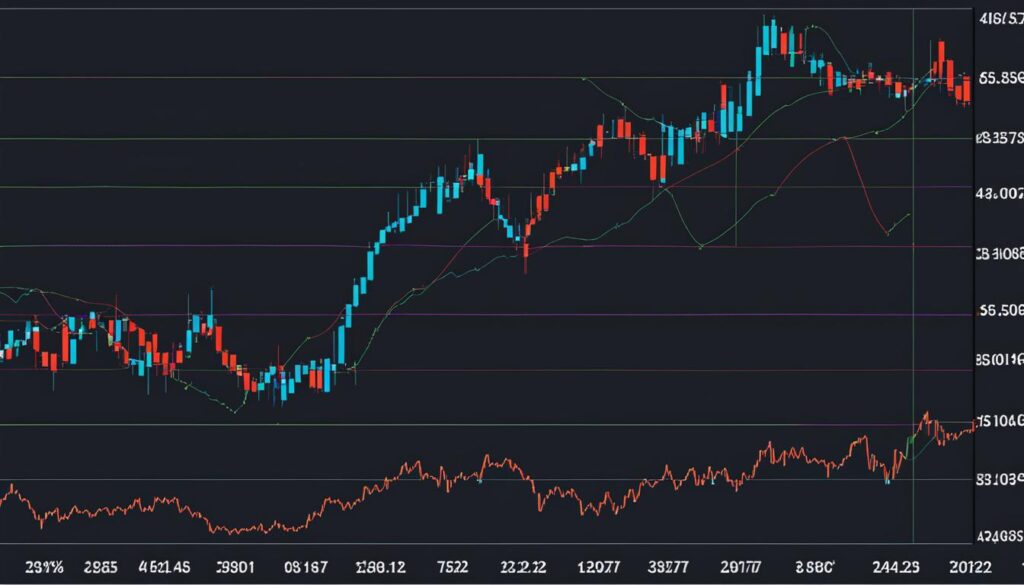When it comes to navigating volatile markets, advanced options trading strategies like dispersion trading can offer opportunities for savvy traders. Dispersion trading is a sophisticated approach that capitalizes on the differences in implied volatility between index options and options on individual stocks, aiming to profit from the disparity. This strategy takes advantage of the fact that the implied volatility of index options is generally lower than that of individual stock options.
While dispersion trading can be a potentially profitable strategy, it is important to note that it is not suitable for beginners. It requires advanced knowledge of options and market dynamics. Traders must have a deep understanding of how options work and the factors influencing volatility in order to effectively implement dispersion trading.
Key Takeaways:
- Dispersion trading capitalizes on the differences in implied volatility between index options and options on individual stocks.
- This advanced strategy takes advantage of the fact that implied volatility of index options is generally lower than that of individual stock options.
- Dispersion trading requires advanced knowledge of options and market dynamics and is not suitable for beginners.
- Traders must carefully consider risk management and position sizing when implementing dispersion trading.
- It is important for traders to have a thorough understanding of options and the markets they are trading before attempting dispersion trading.
The Fundamental Reason for Dispersion Trading
The fundamental reason behind dispersion trading lies in the relationship between correlation trading, volatility risk premium, and belief disagreement. This strategy takes advantage of the dispersion in analysts’ forecasts, which is strongly related to the implied volatility of index and single-name options.
Academic research and extensive analysis of financial data support the validity and effectiveness of dispersion trading as a volatility strategy. Research shows that option excess returns reflect the exposure to disagreement risk. By buying options of firms that are more prone to heterogeneity in beliefs, investors are compensated for holding this risk.
“Option excess returns are negatively associated with both lagged and contemporaneous disagreement, stocking the idea that beliefs disagreement affects the premium.”
The volatility risk premia of individual and index options represent compensation for the priced disagreement risk. The size of the belief heterogeneity of a particular firm and the business cycle indicator affect the volatility risk premium.
Key Factors in the Fundamental Reason for Dispersion Trading
- Correlation trading: This strategy seeks to profit from the differences in implied volatility between index options and individual stock options.
- Volatility risk premium: The compensation for holding the risk associated with disagreement among investors and their beliefs.
- Belief disagreement: The heterogeneity in beliefs among investors, which plays a crucial role in the profitability of dispersion trading.
- Academic research: Extensive studies and analysis support the effectiveness of dispersion trading as a volatility strategy.
By understanding and leveraging these key factors, traders can capitalize on the opportunities presented by dispersion trading.
Implementing the Dispersion Trading Strategy
To successfully implement the dispersion trading strategy, I focus on the vast investment universe provided by stocks from the S&P 100 index. This comprehensive selection of stocks offers numerous opportunities for profitable trades.
Trading Vehicles
Ranging from options on individual stocks to options on the index itself, these trading vehicles form the core of my dispersion trading strategy. By utilizing both types of options, I can maximize potential gains while managing risk.
Utilizing Analyst Forecasts
I rely on analyst forecasts of earnings per share from the Institutional Brokers Estimate System (I/B/E/S) database to identify potential trades. The mean absolute difference is calculated and scaled by an indicator of earnings uncertainty to determine the level of belief disagreement for each stock. This information is crucial for making informed trading decisions.
Stock Selection
After sorting the stocks into quintiles based on the size of belief disagreement, I focus on buying puts on stocks with the highest level of belief disagreement. To enhance my trades, I also purchase options of firms that exhibit a high degree of belief disagreement. This selective approach allows me to target stocks with the greatest potential for profit.
Selection Criteria
When selecting individual options, I consider various factors such as liquidity, option pricing, and expiration dates. These factors ensure that I make well-informed decisions and maximize potential returns while minimizing risk.
Example Trade
For instance, using this strategy, I might identify a stock with high belief disagreement and purchase put options for that stock. Simultaneously, I might also purchase call options for another stock with equally high belief disagreement. This trade leverages the belief disagreement between two stocks, capitalizing on the potential price discrepancy in their future movements.
Benefits of the Dispersion Trading Strategy
By implementing the dispersion trading strategy, I can take advantage of the diverse options available across the S&P 100 index. This broad investment universe offers ample opportunities to profit from the volatility differential between index options and options on individual stocks. Additionally, the use of analyst forecasts helps me identify stocks with significant belief disagreement, increasing the probability of successful trades.

Next, I will explore the risks and considerations associated with dispersion trading to ensure a comprehensive understanding of this advanced volatility strategy.
Risks and Considerations in Dispersion Trading
While dispersion trading can offer potential profits, it is not without risks. Traders must carefully manage these risks to protect their investments and maximize their chances of success.
1. Volatility Differential: One of the key risks in dispersion trading is the difference between implied volatility, which is priced into the options, and realized volatility, which is the actual volatility of the underlying stocks. If the realized volatility of the individual stocks turns out to be higher than the implied volatility priced into the options, traders may incur losses on the sold options.
2. Market Dynamics: Dispersion trading requires a deep understanding of options and market dynamics. Traders need to be well-versed in how different factors, such as economic indicators, news events, and market sentiment, can impact stock prices and volatility. Without a solid understanding of these factors, traders may struggle to make informed decisions and effectively manage their positions.
3. Diversification: Another important consideration in dispersion trading is the need for diversification. Traders should spread their positions across multiple stocks and sectors to reduce the impact of any single stock or sector on their overall strategy. Diversification helps to mitigate the risk of a large price move in a single stock significantly affecting the entire portfolio.
4. Risk Management: Proper risk management is crucial in dispersion trading. Traders should carefully select options based on factors such as liquidity, option pricing, and expiration dates. Stop-loss orders and position sizing can be used to limit losses and manage risk exposure. Experienced traders also understand the importance of constant monitoring and adjusting their positions as market conditions change.
It is important to note that dispersion trading is a complex strategy that should only be undertaken by experienced traders who have a thorough understanding of options and the markets they are trading. Beginner traders should focus on building a solid foundation of knowledge before attempting dispersion trading.

“Risk comes from not knowing what you’re doing.” – Warren Buffett
| Key Risks | Considerations |
|---|---|
| Volatility Differential | If realized volatility is higher than implied volatility, losses may occur. |
| Market Dynamics | A deep understanding of options and market factors is essential for successful trading. |
| Diversification | Spreading positions across multiple stocks and sectors reduces risk exposure. |
| Risk Management | Careful selection of options, stop-loss orders, and position sizing can mitigate risks. |
Conclusion
Dispersion trading is an advanced volatility strategy that offers potential opportunities for experienced traders in the options market. By taking advantage of the differences in implied volatility between index options and individual stock options, traders can aim to profit from the implied volatility differential while maintaining a market-neutral position.
However, it is important to note that dispersion trading is a complex strategy that requires a deep understanding of options and market dynamics. It is not suitable for beginners and should be approached with caution. Traders interested in implementing dispersion trading should first gain experience in trading options and develop a thorough understanding of the factors that drive the implied volatility of different options.
To succeed in dispersion trading, traders need to carefully select options based on factors such as liquidity, option pricing, and expiration dates. Risk management is crucial, and traders should consider diversifying their positions across multiple stocks and sectors to mitigate potential losses. Stop-loss orders and proper position sizing can also help manage risks effectively.
In conclusion, dispersion trading can be an effective advanced volatility strategy for experienced traders. By capitalizing on the differences in implied volatility, traders can potentially generate profits while maintaining a market-neutral position. However, thorough knowledge of options and market dynamics is essential, and traders should approach dispersion trading with caution and implement robust risk management strategies.
FAQ
What is dispersion trading?
Dispersion trading is a complex but potentially profitable strategy that aims to capitalize on the differences in implied volatility between index options and options on individual stocks.
How does dispersion trading work?
Dispersion trading involves selling options on the index and buying options on individual stocks to profit from the implied volatility differential.
Is dispersion trading suitable for beginners?
No, dispersion trading requires advanced knowledge of options and market dynamics and is not suitable for beginners.
What is the fundamental reason behind dispersion trading?
The fundamental reason behind dispersion trading lies in the relationship between correlation, volatility risk premium, and belief disagreement.
How can I implement the dispersion trading strategy?
To implement the dispersion trading strategy, traders focus on the investment universe of stocks from the S&P 100 index and use options on individual stocks and the index itself as trading vehicles.
What are the risks involved in dispersion trading?
Risks in dispersion trading include the possibility of losses if the realized volatility of individual stocks is higher than the implied volatility priced into the options.
How can I manage the risks in dispersion trading?
Risk management in dispersion trading involves carefully selecting options, diversifying positions across multiple stocks and sectors, and using stop-loss orders and position sizing.
Can dispersion trading be profitable?
Dispersion trading can offer potential profits if executed correctly and if the implied volatility differential is favorable.



